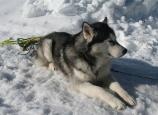
This is a placeholder text
Group text
by GSD Lineage on 27 October 2014 - 22:10
'The Last Husky: The Final Journey of Antarctica's Sledge Dogs' Documentary
Published on Nov 1, 2013
A film from the P&O Archive - An edited version of 'The Last Husky: The Final Journey of Antarctica's Sledge Dogs' who travelled on P&O Maritime's AURORA AUSTRALIS in 1993.
The Protocol on Environmental Protection to the Antarctic Treaty, also known as the Antarctic-Environmental Protocol, or the Madrid Protocol, is part of the Antarctic Treaty System. It provides for comprehensive protection of the Antarctic environment and dependent and associated ecosystems.
by GSD Lineage on 03 April 2015 - 20:04
The first people to reach the Geographic South Pole were Norwegian Roald Amundsen and his party on December 14, 1911. Amundsen named his camp Polheim and the entire plateau surrounding the Pole King Haakon VII Vidde in honour of King Haakon VII of Norway. Robert Falcon Scott had also returned to Antarctica with his second expedition, the Terra Nova Expedition, in a race against Amundsen to the Pole. Scott and four other men reached the South Pole on January 17, 1912, thirty-four days after Amundsen. On the return trip, Scott and his four companions all died of starvation and extreme cold.
Amundsen was full of praise for his dogs, and scorned the idea that they could not work in such conditions; on 21 November the party travelled 17 miles and climbed 5,000 feet (1,500 m).[127]
Of the 52 dogs that had started in October, 11 had survived, pulling 2 sledges. The journey to the pole and back had taken 99 days—10 fewer than scheduled—and they had covered about 1,860 nautical miles (3,440 km).[146]
(Wikipedia Quotes)
They look more heavy than huskies, but they call them huskies.
Contact information Disclaimer Privacy Statement Copyright Information Terms of Service Cookie policy ↑ Back to top




